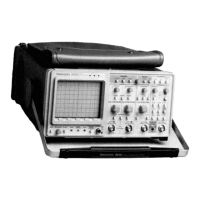SURGE PROTECTION. Thermistors RT717 and RT805
limit the surge current when the power supply is first
turned on. As current warms the thermistors, their resist-
ances decrease and have little effect on circuit operation.
With the selector switch in the 115 V position, the
rectifier and storage capacitors C105 and C305 operate as
a full-wave voltage doubler. When operating in this
configuration, each capacitor is charged on opposite half
cycles of the ac input, and the voltages across the two
capacitors in series approximates the peak-to-peak values
of the source voltage. For 230 V operation, switch S1000
connects the rectifier as a conventional bridge rectifier.
Both capacitors charge on both input half cycles, and the
voltage across C105 and C305 in series approximates the
peak value of the rectified source voltage. For either
configuration (with proper line voltage), the dc voltage sup-
plied to the power supply inverter is the same.
AC Power Input
LINE SWITCHING AND LINE RECTIFIER. Ac line volt-
ages of either 115 V or 230 V may provide the primary
power for the instrument, depending on the setting of the
LINE VOLTAGE SELECTOR switch S1000 (located on the
instrument rear panel). POWER Switch S1350 applies the
selected line voltage to the power supply rectifier (CR510).
The low voltages required by the 2430 are produced by
a high-efficiency, switching power supply (diagram 22).
This type of supply directly rectifies and stores charge
from the ac line supply; then the stored charge is switched
through a special transformer at a high rate, generating
the various supply voltages.
LOW-VOLTAGE POWER SUPPLY
Any time the Phase-Locked Loop is not locked (indicat-
ing that a proper TV Trigger signal is not present), the
Channel 2 Vertical Display Clamp is turned off via R328 by
a HI TVCLAMP signal from the PLL Unlock Detector to
prevent sending invalid offsets to the Channel 2
Preamplifier. During the unlocked state of the PLL, FET
0420
is biased on to pull the input to Offset Buffer
Amplifier U710D to ground, and FET
0710
is biased off via
U710A (acting as an inverter to the TVCLAMP signal) to
open circuit the offset signal line to the Channel 2
Preamplifier.
Offset Buffer Amplifier U710D applies this "stored"
offset level to the Channel 2 Preamplifier (via
0710),
shift-
ing the back porch of the displayed signal to near the on-
screen ground reference (as set with the Vertical POSI-
TION control),
3-90
Since the offset voltage must be maintained throughout
the entire horizontal interval, capacitor C522 (and C520 in
parallel if FASTCLAMP is not enabled) serves as a hold
capacitor between back-porch samples. At some
VOLTS/DIV settings the Channel 2 Preamplifier is set for
higher offset gain. Transistor
0419
will be turned on for
those settings, placing C520 in parallel with C522 to slow
down the loop response. This prevents oscillation in the
Channel 2 Preamplifier at the more sensitive gain settings.
Biasing current to enable the selected Offset Amplifier
is produced during the back-porch interval when U41DA (in
the Trigger Back-Porch Clamp circuit) is turned off. Bias
current through either R411 or R410 (depending on
whether U410B or U410C is off) is supplied via R403. The
other offset amplifier will be disabled since its bias current
is being shunted through the "on" transistor. The amount
of bias current permitted by Transconductance Amplifier
U504 to the "on" amplifier provides a signal to the Chan-
nel 2 Preamplifier (after buffering by U710D) that vertically
offsets the displayed signal on Channel 2.
Selection of either U514 or U520 is controlled by the
CH2 INV signal and is dependent on the setting of the
invert function in the associated COUPLING/INVERT
menu. Since signal offsetting in the Channel 2 Preamplifier
is done before the signal is inverted, offset voltages for
inverted- and normal-signal displays must be of opposite
polarity. Switching between these two offset amplifiers
provides the required polarity change and allows the back
porch of either display type to be clamped at the ground
reference. Depending on the polarity of the CH2 INV
(Channel 2 Invert) signal, either U410E or U410D will
be
on, turning off either U410B or U41DC. U410B will be off
when CH2 INV is HI and U410C will be off when it is LO.
Bias current from the Trigger Back-Porch Clamp circuit to
the offset amplifiers (U514 and U520) is not shunted away
by the "off" transistor, and the offset amplifier associated
with the off transistor will
be
biased on during the sync
pulse back-porch interval.
When the Channel 2 Vertical Display Clamp is enabled,
BCLAMPENA will be HI, turning U420D off. The LO on the
collector of U420D turns
0420
off, enabling Offset Buffer
Amplifier U710D to track the offset level output from the
active Offset Amplifier, and the offset signal line to the
Channel 2 Vertical Preamplifier is connected to the Offset
Buffer by turning on
0710
via U710A.
Offset Buffer. With FET
0710
turned off via U710A, the
offset line to the Channel 2 Vertical Preamplifier is open
circuited, so no trace offsetting can occur.
Theory of Operation-2430 Service

